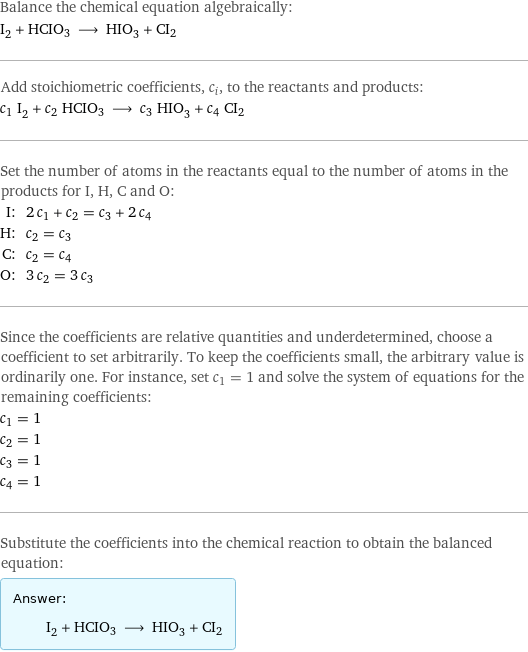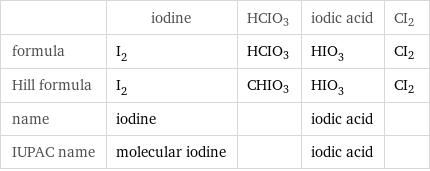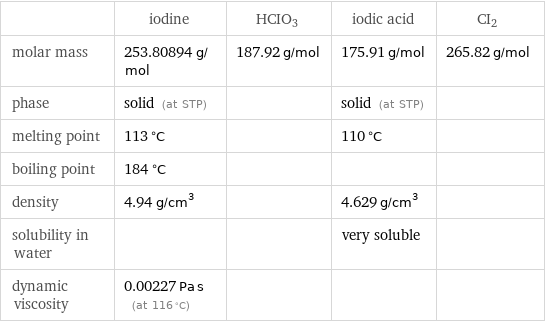Input interpretation

I_2 iodine + HCIO3 ⟶ HIO_3 iodic acid + CI2
Balanced equation

Balance the chemical equation algebraically: I_2 + HCIO3 ⟶ HIO_3 + CI2 Add stoichiometric coefficients, c_i, to the reactants and products: c_1 I_2 + c_2 HCIO3 ⟶ c_3 HIO_3 + c_4 CI2 Set the number of atoms in the reactants equal to the number of atoms in the products for I, H, C and O: I: | 2 c_1 + c_2 = c_3 + 2 c_4 H: | c_2 = c_3 C: | c_2 = c_4 O: | 3 c_2 = 3 c_3 Since the coefficients are relative quantities and underdetermined, choose a coefficient to set arbitrarily. To keep the coefficients small, the arbitrary value is ordinarily one. For instance, set c_1 = 1 and solve the system of equations for the remaining coefficients: c_1 = 1 c_2 = 1 c_3 = 1 c_4 = 1 Substitute the coefficients into the chemical reaction to obtain the balanced equation: Answer: | | I_2 + HCIO3 ⟶ HIO_3 + CI2
Structures

+ HCIO3 ⟶ + CI2
Names

iodine + HCIO3 ⟶ iodic acid + CI2
Equilibrium constant
![Construct the equilibrium constant, K, expression for: I_2 + HCIO3 ⟶ HIO_3 + CI2 Plan: • Balance the chemical equation. • Determine the stoichiometric numbers. • Assemble the activity expression for each chemical species. • Use the activity expressions to build the equilibrium constant expression. Write the balanced chemical equation: I_2 + HCIO3 ⟶ HIO_3 + CI2 Assign stoichiometric numbers, ν_i, using the stoichiometric coefficients, c_i, from the balanced chemical equation in the following manner: ν_i = -c_i for reactants and ν_i = c_i for products: chemical species | c_i | ν_i I_2 | 1 | -1 HCIO3 | 1 | -1 HIO_3 | 1 | 1 CI2 | 1 | 1 Assemble the activity expressions accounting for the state of matter and ν_i: chemical species | c_i | ν_i | activity expression I_2 | 1 | -1 | ([I2])^(-1) HCIO3 | 1 | -1 | ([HCIO3])^(-1) HIO_3 | 1 | 1 | [HIO3] CI2 | 1 | 1 | [CI2] The equilibrium constant symbol in the concentration basis is: K_c Mulitply the activity expressions to arrive at the K_c expression: Answer: | | K_c = ([I2])^(-1) ([HCIO3])^(-1) [HIO3] [CI2] = ([HIO3] [CI2])/([I2] [HCIO3])](../image_source/89d2c3283910d5d34e02e1b63f11108e.png)
Construct the equilibrium constant, K, expression for: I_2 + HCIO3 ⟶ HIO_3 + CI2 Plan: • Balance the chemical equation. • Determine the stoichiometric numbers. • Assemble the activity expression for each chemical species. • Use the activity expressions to build the equilibrium constant expression. Write the balanced chemical equation: I_2 + HCIO3 ⟶ HIO_3 + CI2 Assign stoichiometric numbers, ν_i, using the stoichiometric coefficients, c_i, from the balanced chemical equation in the following manner: ν_i = -c_i for reactants and ν_i = c_i for products: chemical species | c_i | ν_i I_2 | 1 | -1 HCIO3 | 1 | -1 HIO_3 | 1 | 1 CI2 | 1 | 1 Assemble the activity expressions accounting for the state of matter and ν_i: chemical species | c_i | ν_i | activity expression I_2 | 1 | -1 | ([I2])^(-1) HCIO3 | 1 | -1 | ([HCIO3])^(-1) HIO_3 | 1 | 1 | [HIO3] CI2 | 1 | 1 | [CI2] The equilibrium constant symbol in the concentration basis is: K_c Mulitply the activity expressions to arrive at the K_c expression: Answer: | | K_c = ([I2])^(-1) ([HCIO3])^(-1) [HIO3] [CI2] = ([HIO3] [CI2])/([I2] [HCIO3])
Rate of reaction
![Construct the rate of reaction expression for: I_2 + HCIO3 ⟶ HIO_3 + CI2 Plan: • Balance the chemical equation. • Determine the stoichiometric numbers. • Assemble the rate term for each chemical species. • Write the rate of reaction expression. Write the balanced chemical equation: I_2 + HCIO3 ⟶ HIO_3 + CI2 Assign stoichiometric numbers, ν_i, using the stoichiometric coefficients, c_i, from the balanced chemical equation in the following manner: ν_i = -c_i for reactants and ν_i = c_i for products: chemical species | c_i | ν_i I_2 | 1 | -1 HCIO3 | 1 | -1 HIO_3 | 1 | 1 CI2 | 1 | 1 The rate term for each chemical species, B_i, is 1/ν_i(Δ[B_i])/(Δt) where [B_i] is the amount concentration and t is time: chemical species | c_i | ν_i | rate term I_2 | 1 | -1 | -(Δ[I2])/(Δt) HCIO3 | 1 | -1 | -(Δ[HCIO3])/(Δt) HIO_3 | 1 | 1 | (Δ[HIO3])/(Δt) CI2 | 1 | 1 | (Δ[CI2])/(Δt) (for infinitesimal rate of change, replace Δ with d) Set the rate terms equal to each other to arrive at the rate expression: Answer: | | rate = -(Δ[I2])/(Δt) = -(Δ[HCIO3])/(Δt) = (Δ[HIO3])/(Δt) = (Δ[CI2])/(Δt) (assuming constant volume and no accumulation of intermediates or side products)](../image_source/794c73ed9d0c28c4ba245d45a00e3365.png)
Construct the rate of reaction expression for: I_2 + HCIO3 ⟶ HIO_3 + CI2 Plan: • Balance the chemical equation. • Determine the stoichiometric numbers. • Assemble the rate term for each chemical species. • Write the rate of reaction expression. Write the balanced chemical equation: I_2 + HCIO3 ⟶ HIO_3 + CI2 Assign stoichiometric numbers, ν_i, using the stoichiometric coefficients, c_i, from the balanced chemical equation in the following manner: ν_i = -c_i for reactants and ν_i = c_i for products: chemical species | c_i | ν_i I_2 | 1 | -1 HCIO3 | 1 | -1 HIO_3 | 1 | 1 CI2 | 1 | 1 The rate term for each chemical species, B_i, is 1/ν_i(Δ[B_i])/(Δt) where [B_i] is the amount concentration and t is time: chemical species | c_i | ν_i | rate term I_2 | 1 | -1 | -(Δ[I2])/(Δt) HCIO3 | 1 | -1 | -(Δ[HCIO3])/(Δt) HIO_3 | 1 | 1 | (Δ[HIO3])/(Δt) CI2 | 1 | 1 | (Δ[CI2])/(Δt) (for infinitesimal rate of change, replace Δ with d) Set the rate terms equal to each other to arrive at the rate expression: Answer: | | rate = -(Δ[I2])/(Δt) = -(Δ[HCIO3])/(Δt) = (Δ[HIO3])/(Δt) = (Δ[CI2])/(Δt) (assuming constant volume and no accumulation of intermediates or side products)
Chemical names and formulas

| iodine | HCIO3 | iodic acid | CI2 formula | I_2 | HCIO3 | HIO_3 | CI2 Hill formula | I_2 | CHIO3 | HIO_3 | CI2 name | iodine | | iodic acid | IUPAC name | molecular iodine | | iodic acid |
Substance properties

| iodine | HCIO3 | iodic acid | CI2 molar mass | 253.80894 g/mol | 187.92 g/mol | 175.91 g/mol | 265.82 g/mol phase | solid (at STP) | | solid (at STP) | melting point | 113 °C | | 110 °C | boiling point | 184 °C | | | density | 4.94 g/cm^3 | | 4.629 g/cm^3 | solubility in water | | | very soluble | dynamic viscosity | 0.00227 Pa s (at 116 °C) | | |
Units
